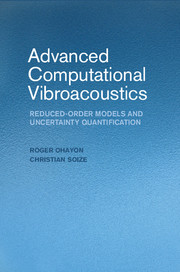Book contents
- Frontmatter
- Contents
- 1 Principal Objectives and a Strategy for Modeling Vibroacoustic Systems
- 2 Definition of the Vibroacoustic System
- 3 External Inviscid Acoustic Fluid Equations
- 4 Internal Dissipative Acoustic Fluid Equations
- 5 Structure Equations
- 6 Vibroacoustic Boundary Value Problem
- 7 Computational Vibroacoustic Model
- 8 Reduced-Order Computational Model
- 9 Uncertainty Quantification in Computational Vibroacoustics
- 10 Symmetric BEM without Spurious Frequencies for the External Acoustic Fluid
- References
- Glossary
- Author Index
- Subject Index
1 - Principal Objectives and a Strategy for Modeling Vibroacoustic Systems
Published online by Cambridge University Press: 05 August 2014
- Frontmatter
- Contents
- 1 Principal Objectives and a Strategy for Modeling Vibroacoustic Systems
- 2 Definition of the Vibroacoustic System
- 3 External Inviscid Acoustic Fluid Equations
- 4 Internal Dissipative Acoustic Fluid Equations
- 5 Structure Equations
- 6 Vibroacoustic Boundary Value Problem
- 7 Computational Vibroacoustic Model
- 8 Reduced-Order Computational Model
- 9 Uncertainty Quantification in Computational Vibroacoustics
- 10 Symmetric BEM without Spurious Frequencies for the External Acoustic Fluid
- References
- Glossary
- Author Index
- Subject Index
Summary
In this book, we are interested in the analysis of vibroacoustic systems, which are also called structural acoustic systems or fluid-structure interactions for compressible fluid (gas or liquid). Vibroacoustics concerns noise and vibration of structural systems coupled with external and/or internal acoustic fluids. Computational vibroacoustics is understood as the numerical methods solving the equations of physics corresponding to vibroacoustics of complex structures. Complex structures are encountered in many industries for which vibroacoustic numerical simulations play an important role in design and certification, such as the aerospace industry (aircrafts, helicopters, launchers, satellites), automotive industry (automobiles, trucks), railway industry (high speed trains), and naval industry (ships, submarines), as well as in energy production industries (electric power plants).
Since we are interested in the analysis of general complex structural systems in the sense of computational methods defined here, we do not consider analytical or semianalytical methods devoted to structures with simple geometry, asymptoticmethods mainly adapted to the high-frequency range (statistical energy analysis, diffusion of energy, etc.) and approaches that imply them. Concerning the latter, the coupling of the local dynamic equilibrium equation (finite element method) and power balances (implemented in the spirit of the statistical energy analysis) have been analyzed in Soize (1998); Shorter and Langley (2005); Cotoni et al. (2007).
Information
- Type
- Chapter
- Information
- Advanced Computational VibroacousticsReduced-Order Models and Uncertainty Quantification, pp. 1 - 12Publisher: Cambridge University PressPrint publication year: 2014
